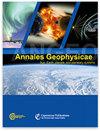Acoustic–gravity waves and their role in ionosphere–lower thermosphere coupling
IF 1.9
4区 地球科学
Q3 ASTRONOMY & ASTROPHYSICS
引用次数: 0
Abstract
Abstract. The properties of acoustic–gravity waves (AGWs) in the ionospheric D layer and their role in the D layer–lower thermosphere coupling are studied using the dispersion equation and the reflection coefficient. These analytical equations are an elegant tool for evaluating the contribution of upward–propagating acoustic and gravity waves to the dynamics of the lower thermosphere. It was found that infrasound waves with frequencies ω > 0.035 s−1, which propagate almost vertically, can reach the lower thermosphere. Also, gravity waves with frequencies lower than ω < 0.0087 s−1, with horizontal phase velocities in the range 159 m/s < vh < 222 m/s, and horizontal wavelength 115 km < λp < 161 km, are important for the lower thermosphere dynamics. These waves can cause temperature rise in the lower thermosphere and have the potential to generate middle–scale traveling ionospheric disturbances (TIDs). The reflection coefficient for AGWs is highly temperature dependent. During maximum solar activity, the temperature of the lower thermosphere can rise several times. This is the situation where infrasound waves become a prime candidate for the ionospheric D layer–lower thermosphere coupling, since strongly reflected gravity waves remain trapped in the D layer. Knowing the temperatures of the particular atmospheric layers, we can also know the characteristics of AGWs and vice versa.声重力波及其在电离层-低温层耦合中的作用
摘要。利用频散方程和反射系数研究了电离层 D 层声波和重力波的特性及其在 D 层-下热层耦合中的作用。这些分析方程是评估向上传播的声波和重力波对下热层动力学的贡献的一种有效工具。研究发现,频率为 ω > 0.035 s-1 的次声波几乎是垂直传播的,可以到达下热层。此外,频率低于 ω < 0.0087 s-1 的重力波,其水平相位速度范围为 159 m/s < vh < 222 m/s,水平波长为 115 km < λp < 161 km,对于下热层动力学也很重要。这些波会导致热大气层下部温度升高,并有可能产生中尺度行进电离层扰动(TIDs)。AGW 的反射系数与温度高度相关。在太阳活动最剧烈的时候,下热层的温度会上升数倍。在这种情况下,次声波成为电离层 D 层-下热层耦合的主要候选波,因为强烈反射的重力波仍被困在 D 层。知道了特定大气层的温度,我们也就知道了 AGW 的特征,反之亦然。
本文章由计算机程序翻译,如有差异,请以英文原文为准。
求助全文
约1分钟内获得全文
求助全文
来源期刊

Annales Geophysicae
地学-地球科学综合
CiteScore
4.30
自引率
0.00%
发文量
42
审稿时长
2 months
期刊介绍:
Annales Geophysicae (ANGEO) is a not-for-profit international multi- and inter-disciplinary scientific open-access journal in the field of solar–terrestrial and planetary sciences. ANGEO publishes original articles and short communications (letters) on research of the Sun–Earth system, including the science of space weather, solar–terrestrial plasma physics, the Earth''s ionosphere and atmosphere, the magnetosphere, and the study of planets and planetary systems, the interaction between the different spheres of a planet, and the interaction across the planetary system. Topics range from space weathering, planetary magnetic field, and planetary interior and surface dynamics to the formation and evolution of planetary systems.
 求助内容:
求助内容: 应助结果提醒方式:
应助结果提醒方式:


